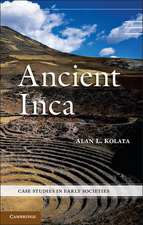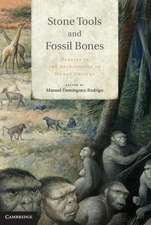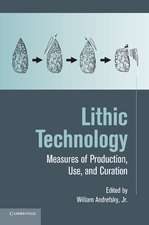Tracing Prehistoric Social Networks through Technology: A Diachronic Perspective on the Aegean: Routledge Studies in Archaeology
Editat de Ann Brysbaerten Limba Engleză Hardback – 25 oct 2011
This book brings together scholars’ expertise in a variety of different fields ranging from historical archaeology (using textual evidence), archaeometry, geoarchaeology, experimental work, archaeobotany, and archaeozoology. Chapters in this volume study and contextualize archaeological remains and explore networks of crafts-people, craft traditions, or people who employed various technologies to survive. Central questions in this context are how and why traditions, techniques, and technologies change or remain stable, or where and why cross-cultural boundaries developed and disintegrated.
| Toate formatele și edițiile | Preț | Express |
|---|---|---|
| Paperback (1) | 483.49 lei 6-8 săpt. | |
| Taylor & Francis – 30 mai 2014 | 483.49 lei 6-8 săpt. | |
| Hardback (1) | 1059.14 lei 6-8 săpt. | |
| Taylor & Francis – 25 oct 2011 | 1059.14 lei 6-8 săpt. |
Din seria Routledge Studies in Archaeology
- 18%
 Preț: 643.87 lei
Preț: 643.87 lei -
 Preț: 310.22 lei
Preț: 310.22 lei -
 Preț: 326.26 lei
Preț: 326.26 lei -
 Preț: 342.68 lei
Preț: 342.68 lei -
 Preț: 309.65 lei
Preț: 309.65 lei - 26%
 Preț: 766.16 lei
Preț: 766.16 lei - 18%
 Preț: 1108.37 lei
Preț: 1108.37 lei -
 Preț: 384.59 lei
Preț: 384.59 lei -
 Preț: 483.49 lei
Preț: 483.49 lei - 30%
 Preț: 822.76 lei
Preț: 822.76 lei -
 Preț: 389.38 lei
Preț: 389.38 lei - 25%
 Preț: 773.99 lei
Preț: 773.99 lei - 18%
 Preț: 1062.62 lei
Preț: 1062.62 lei -
 Preț: 423.30 lei
Preț: 423.30 lei -
 Preț: 383.50 lei
Preț: 383.50 lei -
 Preț: 388.34 lei
Preț: 388.34 lei -
 Preț: 383.50 lei
Preț: 383.50 lei - 18%
 Preț: 1108.42 lei
Preț: 1108.42 lei - 18%
 Preț: 1064.70 lei
Preț: 1064.70 lei -
 Preț: 389.38 lei
Preț: 389.38 lei - 18%
 Preț: 1113.16 lei
Preț: 1113.16 lei - 18%
 Preț: 1114.70 lei
Preț: 1114.70 lei -
 Preț: 492.54 lei
Preț: 492.54 lei - 18%
 Preț: 1109.18 lei
Preț: 1109.18 lei - 25%
 Preț: 769.55 lei
Preț: 769.55 lei -
 Preț: 480.62 lei
Preț: 480.62 lei -
 Preț: 469.34 lei
Preț: 469.34 lei - 25%
 Preț: 767.89 lei
Preț: 767.89 lei - 18%
 Preț: 1072.71 lei
Preț: 1072.71 lei - 25%
 Preț: 770.62 lei
Preț: 770.62 lei - 25%
 Preț: 823.99 lei
Preț: 823.99 lei -
 Preț: 388.72 lei
Preț: 388.72 lei - 21%
 Preț: 256.87 lei
Preț: 256.87 lei - 18%
 Preț: 1060.52 lei
Preț: 1060.52 lei -
 Preț: 434.63 lei
Preț: 434.63 lei -
 Preț: 485.46 lei
Preț: 485.46 lei
Preț: 1059.14 lei
Preț vechi: 1291.63 lei
-18% Nou
Puncte Express: 1589
Preț estimativ în valută:
202.69€ • 220.09$ • 170.26£
202.69€ • 220.09$ • 170.26£
Carte tipărită la comandă
Livrare economică 22 aprilie-06 mai
Preluare comenzi: 021 569.72.76
Specificații
ISBN-13: 9780415896160
ISBN-10: 0415896169
Pagini: 240
Ilustrații: 8 tables and 21 halftones
Dimensiuni: 152 x 229 x 14 mm
Greutate: 0.58 kg
Ediția:1
Editura: Taylor & Francis
Colecția Routledge
Seria Routledge Studies in Archaeology
Locul publicării:Oxford, United Kingdom
ISBN-10: 0415896169
Pagini: 240
Ilustrații: 8 tables and 21 halftones
Dimensiuni: 152 x 229 x 14 mm
Greutate: 0.58 kg
Ediția:1
Editura: Taylor & Francis
Colecția Routledge
Seria Routledge Studies in Archaeology
Locul publicării:Oxford, United Kingdom
Public țintă
Postgraduate, Professional, and UndergraduateCuprins
Introduction. Tracing Social Networks through Studying Technologies. Ann Brysbaert 1. Disentangling Neolithic Networks: Ground Stone Technology, Material Engagements and Networks of Action. Christina Tsoraki 2. ‘Thou Shall Make Many Images of thy Gods’. A Chaîne Opératoire Approach to Mycenaean Religious Rituals Based on Iconographic and Contextual Analyses of Plaster and Terracotta Figures. Melissa Vetters 3. Technologies of Sound across Aegean Crafts and Mediterranean Cultures. Manolis Mikrakis 4. A War of Words: Comparing the Performative Cross-Craft Interaction of Physical Violence and Oral Expression in the Mycenaean World. Katherine Harrell 5. Ke-ra-me-u or Ke-ra-me-ja? Evidence for Sex, Age, and Division of Labor among Mycenaean Ceramicists. Julie Hruby 6. Links of Clay in Neolithic Greece: the Case of Platia Magoula Zarkou. Areti Pentedeka 7. Storage Technologies as Embedded Social Practices: Studying Pithos Storage in Prehistoric Northern Greece. Despina Margomenou and Maria Roumpou 8. Aegean Bronze Age Weights, Chaînes Opératoires, and the Detecting of Patterns through Statistical Analyses. Jari Pakkanen 9. Business as Usual: Cypriot Demand for Aegean Pottery during the Late Bronze Age. Angelos Papadopoulos 10. Technologies of Re-using and Recycling in the Aegean and Beyond. Ann Brysbaert
Descriere
This volume investigates small and large networks of contacts within and across the Aegean and nearby regions, covering periods from the Neolithic until Classical times (6000–323 BC). It explores the world of technologies, crafts, and archaeological 'left-overs' in order to place social and technological networks in their larger economic and political contexts. Examining ways of production, transport/distribution, and consumption, this book covers a chronologically large period in order to expand our understanding of wider cultural developments inside the geographical boundaries of the Aegean and its regions of contact in the east Mediterranean.













